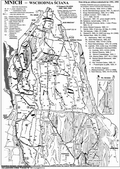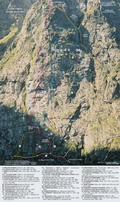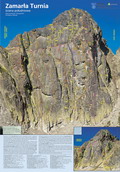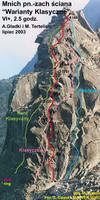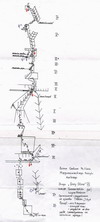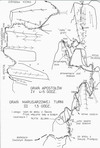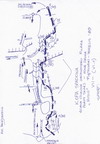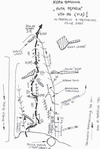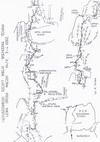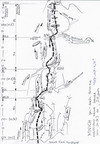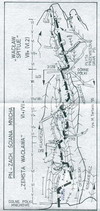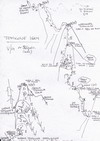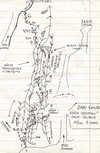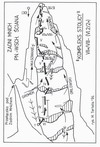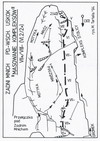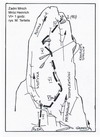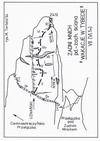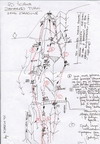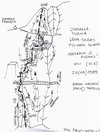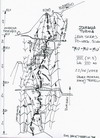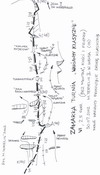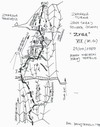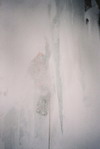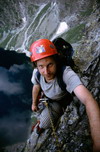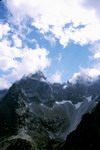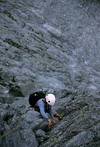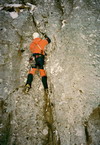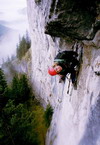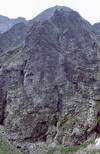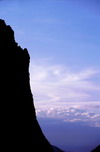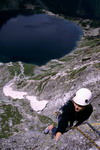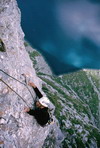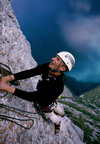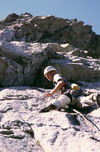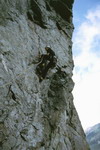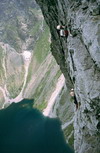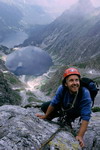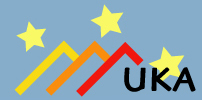
| nowości forum klub ścianka kurs sekcja juniorów teksty topo galerie linki Łukasz Wajs english |
| Jura |
| Kamieniec |
| Morskie Oko |
Morskie Oko
author: Jakub Radziejowski
photographs: Grzegorz Głazek, Paweł Józefowicz, Jakub Radziejowski, Maciej Tertelis (topos)
proof reading: Graham MartindaleRegion
Morskie Oko Valley (the High Tatras), Southern Poland.
Location and how to get there
South of Poland (region Podhale). A 100 kilometre-long road from the city of Kraków (Cracow) to Zakopane is narrow and overcrowded so it may take even 2-3 hours to drive through, but what wouldn't you do for climbing... You can also get to Zakopane by train (3 h from Kraków).
Zakopane is a tourist resort, called the winter capital of Poland, and you find there a lot of hotels and bed and breakfest houses. There are banks, supermarkets, climbing shops, nice pubs and even a good theatre. Zakopane is the centre of the Polish Tatras which in fact constitues only 20% of the whole Tatras range. The Slovak part of the Tatras is less overcrowded and is surely worth visiting. Climbing in Slovakia may be of great pleasure, particularly on Galeria Gankowa and Młynarczyk (the Białej Wody valley), just across the Polish border at Łysa Polana and on the west face of Łomnica.
The Morskie Oko valley is the most popular place in the Polish Tatras. From Zakopane take a road to the border-crossing at Łysa Polana and drive 3 km. further to the Polana Palenica parking. You have to park your car here (parking is pretty costly - 25 PLN per night) as the further part of the road is closed for unauthorised traffic. It is also possible to take a bus from Zakopane directly to Palenica. After crossing the entrance gate (you have to buy a ticket) to The Tatras National Park (Tatrzański Park Narodowy - TPN) follow the asphalt road approx. 9 km to a refuge.
Don't be surprised by the hordes of Sunday tourists (unfortunately, they appear not only on Sundays...) walking to Morskie Oko, which is one of the most famous places in Poland, and don't be surprised by the kind of a road you take. Yes, you're going the right way - the metalled road leads you directly to the refuge (schronisko) at Morskie Oko. The refuge, known as the most beautiful in the Tatras, is open all-seasons. In the summer you can also stay at the Polish Mountaineering Association's camping place (so called "tabor") that lies 1 km before the Morskie Oko refuge - 8 km from Palenica. Be careful when you are passing a restaurant on the right (at the Włosiennica parking) - just you have passed it, take a path that goes upright into the forest. There are tents so you only need a karrimat and a sleeping bag but the place is for climbers only, so be ready to prove that...
A Brief History of the Region
The history of climbing in Morskie Oko is the history of Polish climbing in general - it is a home arena of Polish climbers.
The story of the conquest of the most honourable walls is a subject of the most inspiring stories. Of course, not many people care about the dates of the first ascent of Rysy (the highest peak in the Polish Tatras) or Mnich. Instead, everybody knows the names and the years of the first ascents of the hardest problems at Morskie Oko.
Most of the big walls at Morskie Oko (well, not very big walls in the absolute terms, but in the Tatras everything higher than 300 meters is pretty big) were climbed for the first time before or during the 2nd World War: the east face of Mięguszowiecki Szczyt (MSW) and the north face of Mięguszowiecki Szczyt Pośredni - both climbed by Mieczysław Świerz, the north east face of Kazalnica (Korosadowicz and later Łapiński and Paszucha - 1943), the north east pillar, and the north face of Mięguszowiecki Szczyt.
But the 'real problems', which have since become history, still remained to be solved. The middle part of the east face of Mnich (The Monk) called "Wariant R" was the first very technical aid climb in Poland (climbed in 1955). The climbs of the left part (the '50) and the Pillar of Kazalnica (1962) solved the first big problems on our most honourable wall.
And the winter is even harder: fixed ropes were installed during the first winter ascent of Łapiński-Paszucha route on Kazalnica. All these facts are the ABC for every climbing beginner in Poland.
Since that time a lot of bigger and smaller problems had been solved, mainly via hard aid techniques. In the '80 and '90 the era of free climbing came with its technical progress and bolting. And it leads directly to the never-ending discussion between traditionalists and modernists with the question of "to bolt or not to bolt". Last year (2003) ended with ten fully bolted sport climbs in the Polish Tatras. The discussion goes on...
Character of the Climbing
In general, climbing in the High Tatras can be called middle-sized mountain climbing. You will not find any glaciers and 1000 meters routes here - only in winter some routes are so long.
The quality of Tatra granite varies from the best quality compact slabs and cracks of Mnich and the central part of Kazalnica to Dolomite-like rubbish on some other peaks.
There are no south faces in Morskie Oko. There is a little bit of west face climbing (Żabi Mnich, Kopa Spadowa, Niżnie Rysy), and the rest is north and north-east face climbing.
The hardest routes are on Mnich and Kazalnica (up to UIAA IX+) Some of them are fully bolted, others require friends and nuts on easier pitches.
Kazalnica is the steepest and the biggest wall in Morskie Oko. In winter you can climb for almost 600 meters - in summer you avoid first 200 meters of turf and grass by easy rock climbing. The best routes lie in the central part of the wall - graded from VI+ up to IX+ (2 routes). Some of them are bolted, but a few still require pitons. There is also a few hard aid-climbs (up to A3) with a spectacular new route - Bushido (VIII, A3) - done solo, last summer in 12 hours.
Mnich is much lower (only 250 meters of climbable terrain) but the peak looks like a younger brother of famous Petit Dru. On the better eastern face you will find routes from VII- to IX+. Some of these are fully bolted while others still require nuts and friends. The north and north west faces of Mnich offer easier climbs from grade IV up to VIII-.
Bigger, but not as solid as Mnich's, is the east face of Mięguszowiecki Szczyt (350 m high) with a set of routes from V to VII - and there are still no bolts on the wall. Of course, you don't need pitons on classics like Świerz and Surdel, but some routes will not go without them.
There are also a few nice but short walls (up to 200 m) where you can find good climbing on compact rock - from fully bolted routes up to aid hard-cores.
- The lower part of the MSW Pillar (so called "Czołówka MSW") with routes from V+ up to VIII (fully bolted), and aid routes up to A3;
- Mniszek (very close to Mnich) with several nice routes from VI to VIII- (the hardest is called British Traverses - no bolts);
- Żabi Mnich (very nice 4 pitches of climbing on the west face) - routes from V up to VII (bolted). You'll also find here some VI+'s with reputation of uneasy protection;
- Kopa Spadowa - routes up to fully bolted VII+;
- Zadni Mnich, very short, only 2-3 pitches routes, but on perfect granite - up to VIII-.
What else will you find? On the north faces of ŻTM (Żabia Turnia Mięguszowiecka - 350 m) and Wołowa Turnia (400 m) are routes up to VII on traditional protection and some aid as well. This along with the Żabi Koń's short north face is called the coldest triangle in the Polish Tatras...
In winter the situation changes radically: the pleasant short climbs change into the school of suffering. It is still not Patagonia, but the weather can be abysmal.
The essence of Tatra winter climbing can be described as mixed climbing, but instead of ice you have to deal with frozen turf and grass. In winter, not only such walls like Kazalnica (the hardest thing in the whole Tatras) but also the rest of the walls - not really interesting in summer - turn into good winter problems, just to mention the North Face of Mięguszowiecki Szczyt, Niżnie Rysy's Right Depression, the excellent winter climbs on Cubryna (Turnia Zwornikowa Cubryny) and many, many more. And it is Morskie Oko that is a place of origin the so called Polish School of Suffering which contributed to Polish winter successes in the Himalayas (the '70 and '80).
Personal Recommendations
For me, Morskie Oko is the best valley in the Tatras, even with its overcrowding. Summer can be really beautiful, but it is winter that makes it fantastic.
I recommend following exceptional summer routes:
- The Pillar of Kazalnica IX+, often done as VII, Ae. The "Big Roof" is climbable with quickdraws at A0 or you can avoid it by a rightward traverse (VI). It is the best route in Morskie Oko so don't be petrified by the first 200 meters of scrambling among the grass. Higher up it becomes brilliant. All you need is 12 quickdraws and a set of nuts and cams (4-6).
- Symfonia Klasyczna on Kazalnica (VII/VII+): a demanding first 3 pitches (no protection in-situ - pitons are strongly recommended) than a few hard moves and the upper part which is The Pillar route.
- Warianty Małolata also on Kazalnica. One of the longer easy routes (VI+) - you need only quicdraws and a set of nuts (and 2-3 cams).
- All the remaining routes on Kazalnica :)
- Hobrzański (VII-), Fereński (VII+), and Wariant R (IX-) on Mnich
- Some bolted stuff: Pachniesz Brzoskwinią (VII-) on Kopa Spadowa, Greystone (VII), Porfawora (VIII), Preludium (VIII) on Czołówka MSW, Fantazja (VII-) on Żabi Mnich - take a set of nuts but the hardest pitches are bolted.
- Surdel on the east face of Mięguszowiecki Szczyt
- Szare Zacięcie VI+ ("Grey Corner"), and Czarne Zacięcie VII- ("Black Corner") on Czołówka MSW;
In winter (winter grades):
- All the routes on Kocioł Kazalnicy (the right hand face of Kazalnica) with a special classic - Sprężyna (VI, A1)
- All the routes on Kazalnica (except the bolted ones) with the special mention of Długosz (V+, A1), Pillar (V+, A1), Łapiński-Paszucha (V+, A0), Diretissima (VI, A1) and a lot of hard stuff (Superparanoja, Wish You were here, Czok Kiełkowski, and a new one - lack of the winter ascent yet - Bushido VIII, A3)
- The north face of Mięguszowiecki Szczyt - Classic route (IV), and Diretissima (V)
- The north east Pillar of Mięguszowiecki Szczyt (1200m, V)
- Short routes on the walls to the right of Mnich (Próg dolinki za Mnichem) - for a leisure day :)
- The right-hand depression of the Niżnie Rysy (IV-)
- Węgrzynowicz Chimney on Wołowy Grzbiet (V)
- Momatiuk (VI, A2), Trzy Pory Roku (V+, A2+), Urojenia (V+, A1), Diretissiama (VI, A2+) and other winter stuff on the Cubryna's north east face.
Accommodation
There's not a big choice - in winter you have only the refuge at the side of Morskie Oko lake (prices from 30 PLN per night).
In the summer, the refuge and the Polish Mountaineering Association's campsite (prices from 12 PLN per night in a tent - they are set so you don't need to bring your own).
There is a restaurant in the refuge but a kitchen opens at 8.00 in the morning. Nevertheless, you can eat dinner there and drink a beer.
It is a good idea to sign yourself into the "Book of ascents" before the climb. It is for the Tatra Rescue Service - TOPR - to know what you are going to do. Remember to sign out after the climb otherwise they will launch a rescue expedition!
Sometimes in summer it is hard to get into the refuge due to crowds so avoid it during a day.
Free (or "wild') camping in the mountains is strictly forbidden (but you can bivouac on the wall).
Remember that walking off the marked paths is not allowed in the Park. When going to climb choose the shortest way from the path and have an alpine club ID with you. Park officers may ask you for it.
Guides, Maps, and Websites
topo:
http://www.wspinanie.pl/topo/polska/tatry/mnich/index.htm
http://www.wspinanie.pl/topo/polska/tatry/zadni_mnich/index.htm
http://www.wspinanie.pl/topo/polska/tatry/kopa_spadowa/index.htm
http://www.wspinanie.pl/topo/polska/tatry/index.htm
http://www.topr.com.pl/topr_wspin_schemat.asp - topo of other Tatra areasOther:
http://www.cyf-kr.edu.pl/tpn/ the Tatra National Park web-site
http://www.zakopane.pl/ - tourist information of the town of Zakopane
http://www.topr.pl - the Tatra Mountains Rescue Service (TOPR)The photographs and topos below show not only Morskie Oko valley but also other parts of the Tatras:
-Zamarła Turnia in Pięciu Stawów valley
-Kościelec in Hala Gąsienicowa valley
-Organy in the West Tatras (limestone!)
-Galeria Gankowa and Młynarczyk in the Slovak Białej Wody valleyMasterTopo Posters
Mnich
(c) Grzegorz Głazek, MasterTopoKazalnica
(c) Grzegorz Głazek, MasterTopoZamarła Turnia
(c) Grzegorz Głazek, MasterTopoTopo
Galeria
brak komentarzy.
dodaj nowy komentarz
 |
(c) UKA 2004
zastrzeżenia prawne |
 |
| Publikacja przygotowana i wydana dzięki pomocy finansowej Unii Europejskiej | ||
